How the Indigo Plant makes a magical blue dye

Did you know that natural indigo dye comes from a plant? In this blog, we look at the steps to take the plant from harvest through to the magical indigo blue colour.
Indigo dye traditions
Clothes dyed with natural indigo have such a rich and varied history. It is possible to find these rich blue colours in anything from the samurai protective under clothing, African indigo dyed textiles through to boiler suits and even the ubiquitous denim. It has even been found in an Egyptian pharaoh’s tomb! These days most clothes are dyed using synthetic indigo dyes, first discovered in Germany before the first world war.


Did you know that indigo dye comes from a plant?
Natural indigo comes from a plant, the indigofera which is grown in sub-tropical climates. It is possible to grow it here in the UK but not on a commercial level, woad is more suited to this climate.


I even have my own Japanese indigo plant that I grew at my home. It looks a bit like a basil plant and is also an annual with a long growing season. This makes it hard to cultivate in the UK and Europe. Be wary of planting in the ground as the type of indigo that grows well in the UK is a relation of Japanese knotweed, so it can spread, but frosts will kill it so don’t panic.
Indian Indigo loves sun and is more naturally found in countries like India, Bangladesh and some central and southern American countries. It has smaller leaves compared to the Japanese indigo, and has beautiful fuchsia like flowers. Indigo dye is extracted from the leaves of the plant. In all species the best time to harvest the leaves for dye is just before it starts to flower and at first light.


Approaches to creating indigo dye in different regions
West Africa
At the ancient Kofar Mata Dye Pit in Nigeria, they harvest the indigo plants, then create balls of leaves, flowers and stems. Next, they make them into a pulp and leave them to dry in the sun. Roughly 100kg of indigo is needed for one pit. The artisans then dye the fabric using tie-resist or stitches to make the traditional resist patterns.
India
Whilst natural dye is seeing a resurgence in popularity, we still need to be aware that it is quite a labour-intensive process to take from indigo plant through to a dye that is ready to use and requires high levels of skill and knowledge, in many cases gained over different generations of family.
It starts with harvesting the plant and finishes up as an indigo “cake” or block. Historically, this was called blue gold because it was high value, compact and lasted well for exporting on the spice road.
Plants are usually harvested after 90 days and taken to the local “Neel Kuthi” or indigo extraction centre. The leaves are put into large tanks and left to soak in water until the water turns green. That water or dye is then filtered into a second tank where a sediment starts to from. The sediment is then released into a smaller pot.
Any left-over water can be used to water local fields with no harmful by-products or chemicals involved in the process.
The sediment is boiled for 1-2 hours in a copper pot to reduce. It’s then filtered again and cut into cakes. The cakes are left to dry in the shade. Once they are dry, they then can be sold in cake form or as a powder.
The Japanese have another method of indigo dye exaction, known as sukumo and is an extremely complex process that has gone on for centuries. It is another variation of indigo extraction that I will go into in another blog post.
Interesting fact: Did you know that you can keep a vat of indigo dye ready for dyeing fabrics going for many years by looking after it? Some artisans describe it like looking after a small child that needs to be fed and rested and cared for in order for it to thrive!
Interestingly, the cloth that comes out of the vats after it has been dyed is a leaf green, but quickly turns blue with oxidisation. A light or dark colour can be created by dipping the fabric multiple times to layer the colour. Clothes dyed with natural indigo get more beautiful with time, reflected by people who pay extra to buy denim jeans that have already been “aged” or the denim heads who buy Japanese indigo woven on old American looms. These denim lovers don’t wash their jeans but instead allow them to age naturally with wear personal to each wearer. They wash gently in cold water and sometimes use white vinegar as a gentle cleaner.


Natural indigo: a sustainable alternative to chemical dyes
One of the things that makes natural indigo dye sustainable is that after the indigo pigment is extracted, water can safely be put back on the crops. Also, no toxic waste is produced.
Natural indigo is often produced in small rural communities where the origins can be easily traced and the artisans can be paid fairly for their trade, resulting in a stronger local economy in rural regions. One such organisation is Living Blue.
Now that indigo plants are grown in a more sustainable way, they are no longer seen as plants that render the land infertile. Instead they are grown in areas in-between crops.
There is no way that natural indigo dye could be created in enough quantities to support the global demand for indigo dye so the alternative that those who have an interest in protecting natural indigo is to continue to support the growth of “sustainable” fashion or pieces that are high quality and last for years.
Why not try your hand at indigo dyeing with one of my DIY indigo and shibori natural dye kits!


